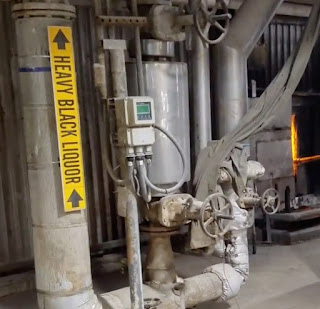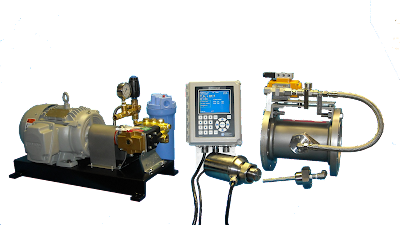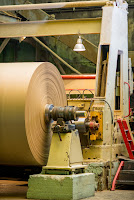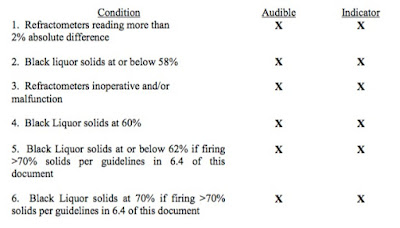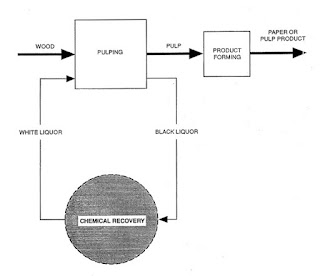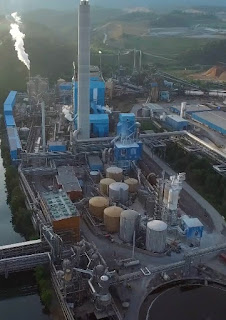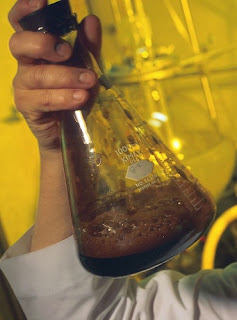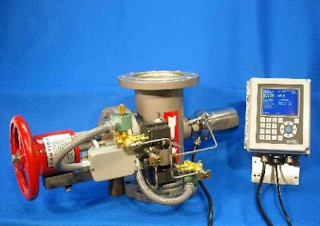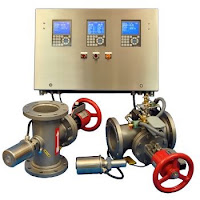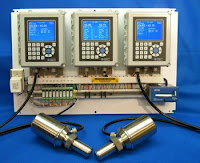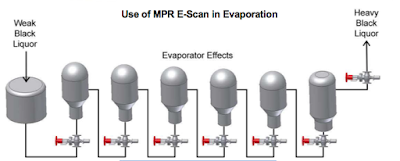The following is reprinted from Chapter 4 of the Black Liquor Recovery Boiler Advisory Board (BLRBAC)
Recommended Good Practice document titled "
Safe Firing of Black Liquor in Black Liquor Recovery Boilers" (April 2016).
Information on the BLRBAC can be found here. The
full document, as well as other important information, can be found here.
Refractometer Black Liquor Solids Measurement System
4.1 General
The heart of the system for the safe firing of black liquor is the ability to correctly, accurately and reliably measure the solids in the black liquor stream immediately prior to the black liquor guns. To accomplish this solids measurement, refractometers have proven to be effective for black liquor recovery boiler service. As new techniques in measuring solids are developed and proven, they can be considered. For the solids measurements, two refractometers in series must be used. When both refractometers are in service, the requirement for an automatic black liquor diversion can be satisfied by either of the following options:
- If either refractometer reads dissolved solids content 58% or below (62% or below if firing >70% solids per guidelines in 6.4 of this document), an automatic black liquor diversion must take place.
- When both refractometers read dissolved solids content 58% or below (62% or below if firing >70% solids per guidelines in 6.4 of this document), an automatic black liquor diversion must take place.
Either option is satisfactory.
If the instrument readings disagree on the percent solids by 2% absolute value, an audible and visual alarm must be given.
If one refractometer fails, or is removed from service, black liquor diversion must then be controlled by the remaining in-service instrument; and if this remaining instrument reads 58% or below solids, an automatic black liquor diversion must take place (62% or below solids if firing >70% solids per guidelines in 6.4 of this document). Black liquor shall not be fired if neither refractometer is in service. The refractometers should be part of a specifically integrated system adapted to the black liquor service, and include a system to monitor their operation and indicate trouble or failure of the individual refractometer. Refractometers used without such a monitoring system can fail unsafe and can give improper and unsafe dissolved solids readings under certain conditions.
4.2 Refractometer Control System Functions
The refractometer control system shall be capable of performing the following functions:
1. Monitor the positive (+) and negative (-) supply voltage of each refractometer independently. The refractometer's supply voltage shall be maintained within the predetermined minimum and maximum limits for safe operation.
2. Monitor the lamp voltage or lamp output of each refractometer independently. The refractometers’ lamp voltage must be within the predetermined minimum and maximum limits for safe operation.
3. Monitor the signal amplitude (if chopper circuit devices are used) of each refractometer independently. Each refractometer's signal amplitude must be maintained within the predetermined minimum and maximum limits for safe operation.
4. Monitor the liquor temperature at each refractometer’s sensing head independently assuring that each refractometer's liquor temperature is within the predetermined minimum and maximum limits for safe operation.
5. Monitor the automatic prism cleaning timer system of each refractometer. The sensor output circuit, prior to the hold circuit, should go negative or adequately decrease during the purge cycle.
6. Monitor the automatic prism cleaning timer system to assure that the purge occurs within the predetermined time.
7. Monitor the cooling water to each refractometer sensing head to assure that cooling water is not lost to a sensing head.
If any of these malfunctions (Items 1 through 7) occur, the following action shall be initiated:
a) An alarm shall be activated, identifying the refractometer and circuit at fault.
b) The refractometer shall be electrically removed from the refractometer control system.
c) The remaining “good” refractometer shall remain in service.
8. Compare the refractometer meter outputs. If a difference of 2% (absolute value) solids or greater exists between refractometer readings, an alarm shall be activated.
9. Performs a black liquor diversion, if one refractometer is removed from service or fails in prism wash, and the remaining refractometer fails or reads a solids of 58% or less.
10. Monitor all cables from the refractometer and the components of the control system. If any cable is cut or removed, an alarm shall be activated.
11. Provide primary alarm or diversion functions by a means other than the refractometer indicating meter’s contacts.
12. Have the capability to allow the manual removal of either refractometer from service retaining the remaining refractometer in full service for diversion purposes.
13. Require a manual reset following a black liquor diversion or malfunction of the refractometer control system.
14. Monitor the position of the sensing head isolation valves. A partially closed or closed valve shall activate an alarm and remove the refractometer from service.
15. Initiate a low solids alarm signal from each refractometer at 60% solids or at 70% solids if firing >70% solids per guidelines in 6.4 of this document.
16. Prohibit the simultaneous washing of the individual refractometers.
17. Require manual restoration of a refractometer which has been removed, either automatically or manually, from service.
18. Have provisions for manual prism washing.
19. Require an automatic switch to single refractometer diversion (for systems set to require both refractometers read low solids to divert – dual refractometer diversion) when one refractometer is in a prism wash cycle. Automatic return to the chosen dual refractometer diversion will occur after completion of the prism wash cycle.
All of the above functions may not apply to all refractometer control systems since some refractometers:
a) Do not utilize cooling water,
b) Have sensing heads that are not affected by liquor temperature, etc.,
c) May have differences in electronic circuitry.
4.3 Refractometer Control System - Controls & Indicators
The refractometer system shall be equipped with the following controls and indicators:
1. Reset switch.
2. Switch or other means to manually remove either refractometer from service.
3. Visual solids display for each refractometer.
4. Status lights indicating “in service”. “inoperative” and/or “malfunction” for the individual refractometer and status of diversion valve.
4.4 Refractometer Control System - Alarms and Indicators
The recommended alarms and indicators of the refractometer control system are:
4.5 Installation Requirements
1. The refractometers shall be installed in series.
2. The refractometer sensing heads shall be installed in such a manner that the individual sensing heads can be taken out of service or removed without having to valve off the liquor piping or open bypass valves.
3. All cabinets, wiring, etc., shall be suitable for the atmosphere and service conditions normal to a recovery boiler installation.
4. The refractometer sensing heads shall be installed so that the y are accessible and readily serviceable.
5. The refractometer sensing heads may be installed in any position on a vertical pipe run. On a horizontal run of pipe, the sensing heads must be installed on sides of the pipe. The reason for this is to ensure that the prisms are always covered with liquor.
6. The electrical power supply to the refractometer control system shall be from a dependable (stable) source.
7. A dependable supply of cooling water of satisfactory capacity must be provided for refractometers requiring sensing head cooling water.
8. Dry oil-free instrument air shall be provided to the refractometer sensing heads to prevent and control condensation in the heads.
9. A steam supply source of sufficient capacity shall be provided to meet flow, and minimum and maximum pressures requirements. All installation requirements may not apply to all refractometers and refractometer systems.
4.6 Refractometer Problems
The three major causes of refractometer trouble or failure are:
1. Loss of cooling water and its effect on the sensing head.
2. Lack of reliability of the prism wash.
3. Condensation in the sensing head.
These may not apply to all refractometers due to differences in construction and circuitry.
4.7 Cooling Water Loss
It is of vital importance that the loss of cooling water be detected. This may be done through a temperature sensing element or flow monitor which shuts down the refractometer involved.
Damage to the sensing element of a refractometer does not occur instantaneously, but it is essential that the system detect abnormal temperatures due to cooling water loss, flow blockage, etc., and that the cooling water be promptly restored.
The individual refractometer manufacturer’s instruction and maintenance manuals shall be consulted with reference to: potential damage to the sensing element; identification of a damaged element; how and when to replace a damaged element.
4.8 Prism Wash
The time interval between prism washes may vary with the black liquor composition. It is recommended that the minimum wash period be 7-10 seconds of wash every 20 minutes. Short duration washes at more frequent intervals are more effective than long washes at long intervals. Ideally, steam pressure for prism washing should be 35 psig above the black liquor pressure, plus the pressure required to open the protective check valve.
Awareness must be maintained of the effect of changes to the prism wash programming variables. Various refractometer systems have the capability to adjust: condensate drain time, steam on time, recovery time and interval between wash time. It may be possible to configure the system to have the total time that both refractometers are in their wash cycle represent a significant percentage of operating time. If one refractometer is out of service for repairs and the remaining refractometer is in prism wash, black liquor solids are not being monitored. Prism wash should be minimized to that needed to maintain the system.
If high pressure steam is used, it may abrade the prism. If only high pressure steam is available, a reducing valve shall be used.
The refractometer prism must have a clear polished optical surface, and if it becomes abraded, it must be replaced.
If the prism wash system has not operated properly and the prism becomes coated, it must be removed and properly cleaned.
4.9 Condensation in Sensing Head
Condensate may build up in the refractometer sensing head and if this occurs, the instrument operation will be erratic.
The procedure for determining this condition and for the elimination of excessive moisture in the sensing head is not the same for all refractometers. The manufacturer’s instruction and maintenance manuals shall be consulted and followed carefully.
4.10 Refractometer Calibration Standardization (Zero Offset) to Off-Line Test
A Refractometer Standardization (“zero shifting” or “bias adjustment”) is an adjustment of the refractometer calibration curve to an off-line test to account for un-dissolved solids and/or changes in the black liquor chemistry. This is normally performed while the instrument is actively measuring black liquor solids.
All refractometers shall be verified against a reliable periodic off-line test. (See Chapter 6 – Off-Line Black Liquor Solids Measurement)
The refractometers shall be standardized:
1. On initial start-up of the recovery boiler.
2. At any time it is felt or known that one of the refractometers may be deviating from the known black liquor solids content.
3. Any time there is a 2% difference between refractometers.
The reading of the refractometers shall be checked against the moisture analyzer or microwave analyzer at two hour intervals (8 hour intervals if firing above 70% solids), and the moisture analyzer or microwave analyzer shall be checked by the TAPPI Standard Method, T650-om-05, weekly.
All refractometer standardization changes shall be entered in the recovery boiler “log book.”
4.11 Refractometer Calibration
A Refractometer Calibration involves placing two or more “samples” onto the sensor to generate a refractive index vs. dissolved solids curve. This is typically performed utilizing calibration oils or electronically (depending on supplier) in a controlled environment, while the sensing head is off of the process line.
Calibration procedures shall be done in a manner that does not affect the system’s ability to automatically perform a black liquor diversion utilizing the remaining (active) in-service refractometer. Improper procedures, or those that defeat the monitoring system described in Chapter 4, can result in the system failing in an unsafe condition. Refer to the manufacturer’s appropriate procedures.
If the continuous solids monitor refractometer differs from the off-line test field measurement by more than 2% on an absolute basis, the off-line test results must be confirmed and then if required the continuous monitor refractometer should be standardized and/or recalibrated according to the manufacturer’s recommended procedures. Repeated errors may indicate a failure of a refractometer component. Refer to the manufacturer’s recommendations for repair or replacement.





